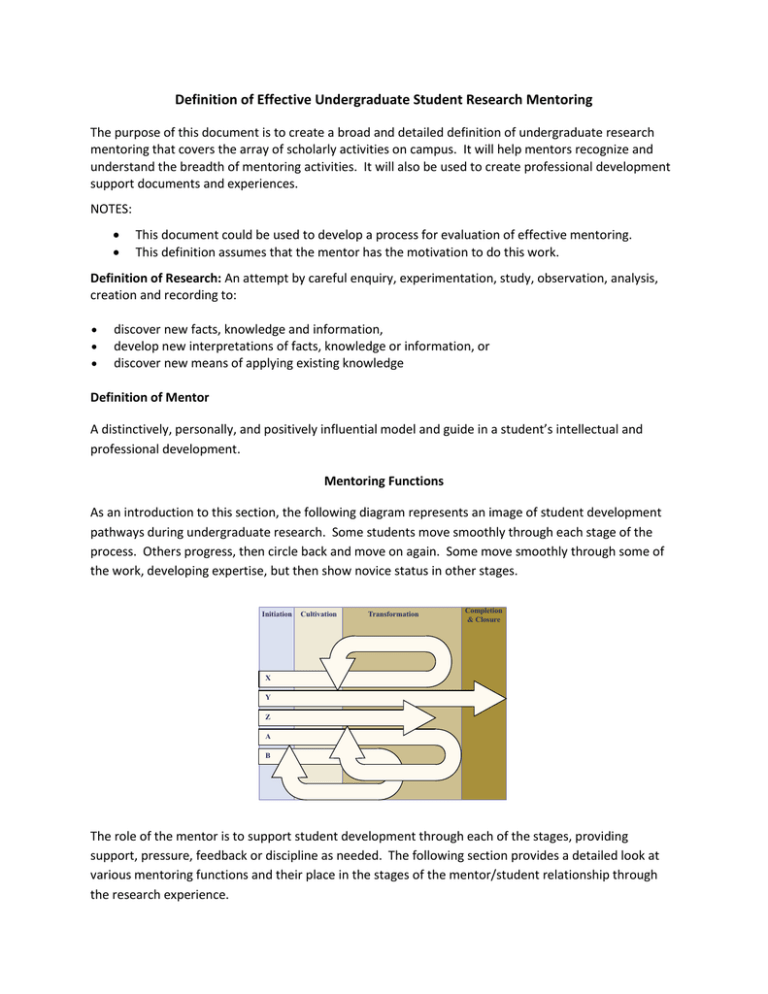Definition of Effective Undergraduate Student Research Mentoring
advertisement

Definition of Effective Undergraduate Student Research Mentoring The purpose of this document is to create a broad and detailed definition of undergraduate research mentoring that covers the array of scholarly activities on campus. It will help mentors recognize and understand the breadth of mentoring activities. It will also be used to create professional development support documents and experiences. NOTES: This document could be used to develop a process for evaluation of effective mentoring. This definition assumes that the mentor has the motivation to do this work. Definition of Research: An attempt by careful enquiry, experimentation, study, observation, analysis, creation and recording to: discover new facts, knowledge and information, develop new interpretations of facts, knowledge or information, or discover new means of applying existing knowledge Definition of Mentor A distinctively, personally, and positively influential model and guide in a student’s intellectual and professional development. Mentoring Functions As an introduction to this section, the following diagram represents an image of student development pathways during undergraduate research. Some students move smoothly through each stage of the process. Others progress, then circle back and move on again. Some move smoothly through some of the work, developing expertise, but then show novice status in other stages. Initiation Cultivation Transformation Completion & Closure X Y Z A B The role of the mentor is to support student development through each of the stages, providing support, pressure, feedback or discipline as needed. The following section provides a detailed look at various mentoring functions and their place in the stages of the mentor/student relationship through the research experience. 1. Professional Competency – Knowledge of disciplinary concepts and processes The mentor is knowledgeable and up to date in his/her field of expertise. The mentor helps student learn background information that represents the depth and breadth of knowledge in the discipline. The mentor knows how to do scholarly work in the discipline, e.g. create, inquire, research, practice and/or perform. Mentor understands and implements effective research mentoring practices. 2. Design and development skills – Creation and implementation of effective scholarly projects o Identify type(s) of research: Discovery, application, integration, teaching/learning (Boyer’s categories) o Define project outcomes, both professional and personal o Research problem/goal, appropriate for UWEC setting o o o Consider and decide on the following project factors: From student-initiated to mentor initiated Scope and timing of the project Student grouping (individuals, groups, experienced/novice) and division of labor Level of student intellectual involvement Course-based or extracurricular Project location (campus-based, local, national, international) Collaborators (colleagues, institutions) Level of client involvement Acquire appropriate resources to enable success Plan and adjust scholarly processes as the project proceeds 3. Mentoring practices – Understanding and utilization of effective mentoring processes by the mentor during each of the stages of the mentor/student relationship o o o Recruitment Develop student awareness and understanding of undergraduate research Provoke student curiosity, confidence and appreciation of undergraduate research Explain rewards and responsibilities Be intentional regarding selection process and criteria (e.g. academic strength, equity, diversity, match project to student) Initiation – student initiation of the collaborative research Discuss project background, vision and objectives Communication of expectations and responsibilities (student and mentor) Create work plans and division of labor Prepare more senior students to mentor junior students (if applicable) Cultivation – Knowledge and skill development in students Develop working relationship Be accessible Teach and/or train Clarify performance expectations Initiate sponsorship: share power judiciously Provide information about content and process: demystify the system Challenge students (encourage risk taking and honor failure) Protect and support students when necessary Gather evidence of student performance in research activities Deliver constructive feedback to student Help students learn and practice characteristics of good scholars Be an intentional model of professional and personal behavior in scholarly endeavors Provide exposure to the discipline and promote student visibility o Transformation – students gain confidence and develop independence Shift from direction to coaching as appropriate Enable mentor/student roles and relationship to grow and transform Offer opportunities for student agency o Completion and Closure – completion of project (product) and end of the formal relationship Guide creation of final product Carry out presentation, performance or publication of product Encourage reflection on scholarly experience and relationship, celebration Envision future development for the student, mentor and project 3. Collaborative environment – Creation and maintenance of a supportive and challenging scholarly environment Provide regular encouragement, support and counsel Support long-term goals: nurture the student’s passion and growth Convey passion for learning through the scholarly process Provide clear, constructive critique of student performance and behavior Foster networks or other mentoring relationships (mentoring constellations) Provide professional socialization Self-disclose to encourage and to develop realistic expectations Foster increasing mutuality and collegiality 4. Evaluating Effective Mentoring - For each of the mentoring functions above: Identify mentoring expectations and outcomes Identify Stakeholders in evaluation process (Colleagues, students, Mentor) o Seek information from those who are qualified to provide it Design tools and collect artifacts used to demonstrate competency First develop formative evaluation, then move to summative when appropriate This definition/description leans heavily on Malachowski, Mitchell, 1996, The Mentoring Role in Undergraduate Research. CUR Quarterly, Winter 1996; Volume 12, 91-94 and Johnson, W. Brad, 2007, On Being a Mentor: A Guide for Higher Education Faculty. Mahwah, NJ, Lawrence Erlbaum Associates Publishers, 260pp.